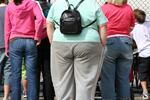But what more should the beverage industry be doing to help solve the problem that many critics say they helped to create?
Non-profit The California Center for Public Health Advocacy (CCPHA) has come up with a list of seven things that the industry could do to drive meaningful change, and still allow the soda corporations to maintain profitability, says executive director Dr. Harold Goldstein.
- Stop all advertising and promotion of sugary drinks to children under the age of 16.
- Print warnings on containers stating the link between consumption and obesity, diabetes and tooth decay.
- Stop selling sugary drinks in parks, afterschool programs and other places frequented by children.
- Put in large print the number of teaspoons of sugar per container.
- Stop marketing sports drinks as healthy beverages.
- Charge more for sugary drinks than equivalent no-calorie beverages.
- Stop promoting the sale of sugary drinks at store entrances, checkout aisles and in store windows.
I don’t mean to be disingenuous at all…

Asked whether he was being disingenuous in arguing that adding health warnings to their drinks would not impact profits, Dr Goldstein told FoodNavigator-USA: “I don’t mean to be disingenuous at all…
“People will certainly drink fewer sugary beverages if they are no longer promoted in such corrosive ways, but we will all still be drinking beverages produced by these same companies. We’ll just be a lot more likely to purchase healthier beverages.
“The truth is, unless people go back to drinking tap water, the beverage industry will continue making as much or more money as ever. Don’t you think?”
What role do sugary beverages play in obesity?
He also defended his claim that "43% of the increase in daily calories Americans consumed over the last 30 years came from sugary drinks" - which is disputed by the industry.
This was sourced from a March 2011 paper published in Public Health Nutrition entitled ‘To what extent have sweetened beverages contributed to the obesity epidemic?’ which concluded that “obesity rates and sweetened beverage intake have increased in tandem in the USA”, he said.
The authors also found that “energy in liquid form is not well compensated for by reductions in the intake of other sources of energy” and estimated that “sweetened beverages account for at least one-fifth of the weight gained between 1977 and 2007 in the US population”.
ABA: Percentage of calories from soda is declining

However, the American Beverage Association (ABA) said that average calories per serving from beverages have dropped 23% since 1998 (Beverage Marketing Corporation), and that sales of full-calorie soda dropped 12.5% between 1999 and 2010 (Beverage Digest).
It also pointed to a 2011 study entitled ‘Consumption of added sugars is decreasing in the United States’ published in the American Journal of Clinical Nutrition concluding that the number of calories in the American diet from added sugars in soda has fallen 39% since 2000.
Meanwhile, ABA has “engaged in a number of initiatives to reduce calories in schools and make calorie labels more consumer-friendly”, Karen Hanretty, vice president, public affairs, told FoodNavigator-USA.
For example, member companies adhere to the Children’s Food and Beverage Advertising Initiative and only advertise juice, water and milk-based drinks to audiences predominately under the age of 12, she said.
Members have also “voluntarily removed full-calorie sodas from schools and replace them with lower-calorie, smaller-portion beverage”, she said. “At the beginning of the 2009-10 school year, shipments of full-calorie carbonated soft drinks to schools dropped by 95%.
“We have also added a consumer-friendly calorie label to the front of every can, bottle and pack we produce.”
Finally, she noted that members will start displaying calorie counts on vending machines this year.
Fewer kids are drinking soda

It can be difficult to get a definitive picture of the role that sugary drinks have played in rising obesity levels over the past 30 years. However the data shows that sales of full-sugar sodas have been falling in the past decade.
According to an analysis of National Health and Nutrition Examination Survey (NHANES) data conducted by the National Cancer Institute; soda, sports drinks, sweetened waters and energy drinks accounted for 5.5% of calories consumed by Americans in 2005-7, said Dr Drewnowski, director of the Center for Public Health Nutrition at the University of Washington.
Drewnowski’s data was presented at the Food & Nutrition Conference & Expo (FNCE) last October, where delegates also heard that the percentage of kids drinking soda fell from 55% of kids aged 6-12 in 2001-2006 to 45% in 2007-2010, according to NHANES data.
However, while sales of full-sugar carbonated soda are falling, sales of sugary energy drinks, sports drinks, and flavored waters are on the rise, claims the CCPHA on its kickthecan website. And this means more empty calories, it claims.
“Sugary beverages are nutritionally bankrupt, they are liquid candy."
Educating consumers is a positive step, adds CCPHA, but it’s not enough: ”Education won't solve the problem if the environment is saturated with sugary beverages.”
More than 20,000 people have signed onto a petition urging the beverage industry to enact these seven steps, including CSPI executive director Michael F. Jacobson, Professor Barry Popkin at the University of North Carolina at Chapel Hill, and Eric Schlosser, author of Fast Food Nation.
